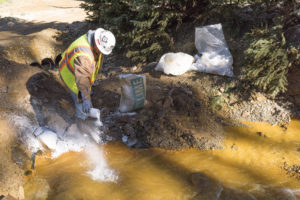A tool for citizens to help protect themselves
The U.S. Environmental Protection Agency’s Toxics Release Inventory (or TRI) gives citizens information about toxic releases in and around their communities. With this information citizens can encourage mining companies to reduce their toxic releases and/or agree to more vigorous oversight of their mines.
Established in 1986 by the Emergency Planning and Community Right-to-Know Act (EPCRA) and administered by the Environmental Protection Agency (EPA), TRI requires industrial facilities to annually disclose to the public the amount of pollutants they have discharged into the air, water, and land or transferred to other sites for incineration, recycling and disposal.
The TRI allows citizens and communities to know, facility-by-facility, county-by-county, state-by-state and industry-by-industry, where the toxics are, and where they’re coming from.
The way the United States discovered its top toxic polluter
Since the metal mining industry started reporting its releases in 1998, the TRI has shown that it is the largest toxic polluter in the United States. In 2010, the metal mining industry reported releasing 1.6 billion pounds of toxics or 41% of all toxics reported.
For selected bioaccumulative toxics, metal mining accounts for the vast majority of all toxics reported. For example, in 2010, metal mining accounted for 96% of all arsenic releases and 92% of all mercury releases.
Something the mining industry fights to hide from, and sometimes wins.
Mining industry lawyers have fought to eliminate and reduce the public’s right to know about mining’s toxic releases ever since the mining industry was required to report.
Unfortunately, industry has won an exemption for some mine waste. Consequently, metal mining operator now report approximately 50% less toxics than it did originally. However, they’re not necessarily releasing less toxics.
To put this in perspective, consider Rio Tinto’s Bingham Canyon mine in Utah — the largest open-pit mine in the United States. Post-lawsuit, the TRI now reports that Bingham Canyon released 182 million pounds of toxics in 2001. However, TRI data accessed before the lawsuit shows that Bingham Canyon released more than 695 million pounds of toxics in 2001 (download .xls), or more than 3 times what’s now indicated.
Those 500 million pounds of toxics no longer reported didn’t disappear. They’re still in waste rock piles surrounding Bingham Canyon mine, less than 25 miles from the Salt Lake City metropolitan area and its more than 1 million residents. But Rio Tinto doesn’t have to report them, and EPA has retroactively erased them.
For More Information
- Environmental Protection Agency: Toxics Release Inventory. Provides access to TRI data through the user-friendly TRI Explorer interface. It also provides downloadable files of the entire TRI, as well as background information about the legal underpinnings and status of TRI.
- Environmental Protection Agency: EPCRA Section 313 Industry Guidance: Metal Mining Facilities
- The Right-To-Know Network: Toxic Releases (TRI) Database. A project of OMB Watch, the RTKnet provides a both the a different way to access the (same) TRI data, and and attempts to put it in context.




